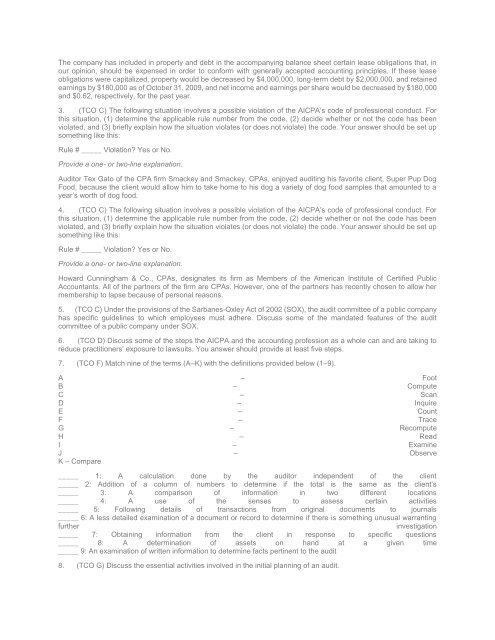ACCT 555 DeVry Midterm Exam
You also want an ePaper? Increase the reach of your titles
YUMPU automatically turns print PDFs into web optimized ePapers that Google loves.
The company has included in property and debt in the accompanying balance sheet certain lease obligations that, in<br />
our opinion, should be expensed in order to conform with generally accepted accounting principles. If these lease<br />
obligations were capitalized, property would be decreased by $4,000,000, long-term debt by $2,000,000, and retained<br />
earnings by $180,000 as of October 31, 2009, and net income and earnings per share would be decreased by $180,000<br />
and $0.62, respectively, for the past year.<br />
3. (TCO C) The following situation involves a possible violation of the AICPA’s code of professional conduct. For<br />
this situation, (1) determine the applicable rule number from the code, (2) decide whether or not the code has been<br />
violated, and (3) briefly explain how the situation violates (or does not violate) the code. Your answer should be set up<br />
something like this:<br />
Rule # _____ Violation? Yes or No.<br />
Provide a one- or two-line explanation.<br />
Auditor Tex Gato of the CPA firm Smackey and Smackey, CPAs, enjoyed auditing his favorite client, Super Pup Dog<br />
Food, because the client would allow him to take home to his dog a variety of dog food samples that amounted to a<br />
year’s worth of dog food.<br />
4. (TCO C) The following situation involves a possible violation of the AICPA’s code of professional conduct. For<br />
this situation, (1) determine the applicable rule number from the code, (2) decide whether or not the code has been<br />
violated, and (3) briefly explain how the situation violates (or does not violate) the code. Your answer should be set up<br />
something like this:<br />
Rule # _____ Violation? Yes or No.<br />
Provide a one- or two-line explanation.<br />
Howard Cunningham & Co., CPAs, designates its firm as Members of the American Institute of Certified Public<br />
Accountants. All of the partners of the firm are CPAs. However, one of the partners has recently chosen to allow her<br />
membership to lapse because of personal reasons.<br />
5. (TCO C) Under the provisions of the Sarbanes-Oxley Act of 2002 (SOX), the audit committee of a public company<br />
has specific guidelines to which employees must adhere. Discuss some of the mandated features of the audit<br />
committee of a public company under SOX.<br />
6. (TCO D) Discuss some of the steps the AICPA and the accounting profession as a whole can and are taking to<br />
reduce practitioners’ exposure to lawsuits. You answer should provide at least five steps.<br />
7. (TCO F) Match nine of the terms (A–K) with the definitions provided below (1–9).<br />
A – Foot<br />
B – Compute<br />
C – Scan<br />
D – Inquire<br />
E – Count<br />
F – Trace<br />
G – Recompute<br />
H – Read<br />
I – <strong>Exam</strong>ine<br />
J – Observe<br />
K – Compare<br />
_____ 1: A calculation done by the auditor independent of the client<br />
_____ 2: Addition of a column of numbers to determine if the total is the same as the client’s<br />
_____ 3: A comparison of information in two different locations<br />
_____ 4: A use of the senses to assess certain activities<br />
_____ 5: Following details of transactions from original documents to journals<br />
_____ 6: A less detailed examination of a document or record to determine if there is something unusual warranting<br />
further<br />
investigation<br />
_____ 7: Obtaining information from the client in response to specific questions<br />
_____ 8: A determination of assets on hand at a given time<br />
_____ 9: An examination of written information to determine facts pertinent to the audit<br />
8. (TCO G) Discuss the essential activities involved in the initial planning of an audit.

















